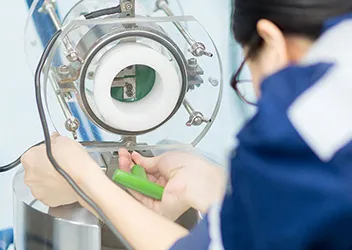DNV GL’s experts are applying 50 years of quantitative risk assessment (QRA) knowledge for natural gas to perform QRA for hydrogen on either side of the gas safety valve into homes. We design experiments to test the knowledge gaps for hydrogen that we find, then build experimental programmes to fill them. These gaps include how hydrogen interacts with soil, how far it travels in the ground, and how it accumulates in the house. This knowledge can then be interpreted into assessing the comparative risks of hydrogen and natural gas for domestic use.
De-risking the use of hydrogen in the home
As part of a UK government-funded programme, Hy4Heat, our experts in the UK are looking at hydrogen on the user’s side of the gas safety valve. Our Loughborough laboratories and the University of Loughborough have jointly conducted research and development (R&D) and testing for Hy4Heat to de-risk using hydrogen in homes and businesses. As part of this work, we:
- have examined hydrogen production and trace impurities to create a draft purity specification
- have consulted with appliance manufacturers and have tested the feasibility and practicality of adding various flame colourants to hydrogen
- are acquiring evidence important for developing hydrogen appliances and testing/certification capabilities.
Specifying the purity of hydrogen supplied to homes is important to guarantee the efficient, trouble-free and economic performance of heating and cooking appliances. Impurities (e.g. sulphur) come from how hydrogen is produced and in its transportation to homes, such as through the cleaning of pipes in gas networks. Some impurities can be very low level, requiring a range of equipment to detect and measure all of them.
Flame visibility is also important for consumer acceptance of gas.
Developing a standard for the hydrogen used in homes
The work by DNV GL and others led to a recommendation in July (2019) that a minimum hydrogen purity level of 98% should be used by manufacturers developing prototype hydrogen appliances and during their subsequent demonstration. Maximum levels for other likely trace components, colourants and odorants were also recommended.
The report making recommendations has filled a critical gap in the knowledge required in the effort being coordinated by the UK’s Institution of Gas Engineers and Managers to develop a hydrogen standard. Having a standard will enable the creation of appliance testing and certification protocols, to provide reassurance for consumers and technical and business certainty for manufacturers.
In a complementary package of work for Hy4Heat, DNV GL experts at our Spadeadam Testing and Research site are comparing the dispersion and accumulation of hydrogen and natural gas within typical domestic properties, and the ignition risk from different gas concentrations.
Testing hydrogen safety in gas networks
On the other side of the gas safety valve, the experts at Spadeadam are also conducting quantitative safety tests coordinated by Northern Gas Networks and funded by a Network Innovation Competition (NIC) project in the UK, to examine how hydrogen would behave in the ground if it leaked from a pipe in a gas network or under a house. The NIC is part of a programme called H21 that proposes converting 3.7 million (m) properties across the UK between 2028 and 2035 to receive hydrogen through existing natural gas pipes, with a possible 12m more by 2050. H21 has already proven the economic feasibility of converting the city of Leeds to hydrogen. Hy4Heat and H21 are complementary, covering the comparative risks of hydrogen (versus natural gas) for the whole system, in the distribution network right through to the appliance.
Demand for risk assessment rises as governments show serious interest in hydrogen for energy
Hy4Heat and H21 are being watched closely worldwide, as the findings will have relevance globally. Driven by Paris Agreement pledges to decarbonize energy, several other nations including Australia, Canada and The Netherlands are looking at hydrogen for heating homes, fuelling transport, and other energy needs. The employment implications of decarbonizing gas networks are also huge. If policy decisions in the UK fall into place, for example, H21’s plans would create a need to convert 20,000 homes per week.
This global interest is driving growing demand for technical advice from our research and testing on hydrogen with customers. Our test facilities and laboratories are working in close partnerships with our customers to make hydrogen a safe and cost-effective contributor in the energy mix in existing networks to meet the future aims of fuel decarbonization. For example, DNV GL has scoped, engineered, and is managing a demonstrator project for Dutch gas network operator Stedin to prove the feasibility of running homes in the Netherlands on 100% hydrogen. We have also advised Norway’s government on hydrogen production options.

